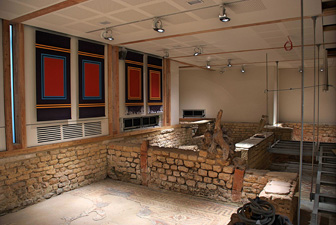Conserving Chedworth’s mosaics

A team of expert conservators are busy preparing some of Britain’s finest mosaics to go on display for the first time in 150 years in a new building at Chedworth Roman Villa in Gloucestershire.
Excavations at the villa have uncovered more mosaics – including one of the country’s longest in-situ corridor mosaics - which will go on display inside a new conservation shelter.
Chedworth Roman Villa is undergoing a £3m redevelopment which includes a new conservation shelter over the fragile Roman remains, better visitor facilities and a new education centre.
National Trust archaeologist Martin Papworth said they had known for many years there were more mosaics than those already on display inside two Victorian built timber sheds.
“They were seen and noted during the Victorian excavations at Chedworth but only two areas were put on display under the old shelters. However, when we did some work to check on their condition we were concerned that frost and weather were affecting them and it was agreed they could be better protected by building a new environmental controlled shelter over that whole section of the villa and excavating them for display.”
The mosaics include one of the longest in-situ corridor mosaics in the country at 35 metres long, which will go on display under a special walkway allowing visitors to walk just above the Roman floor.
There is still one section of the corridor mosaic to be excavated and visitors to Chedworth this summer will be able to watch archaeologists at work.
The mosaics previously on display under the Victorian shelters include three mosaics in the Bath House and one in the Triclinium or dining room. The excavations will, for the first time in 150 years, allow the display of the corridor mosaics, and three others - in an additional room and two short corridors.
The majority of the newly excavated mosaics were uncovered in 2009 and then stabilised and protected during the building work.
Chris Cleere, a conservator who specialises in the in-situ conservation of archaeological sites, is working on the mosaics over the winter inside the newly built conservation shelter.
After the excavation any loose tiles – or tesserae - were taped in place to ensure they didn’t move before they were covered.
Chris explained: “The mosaics were wet when they were excavated and now they are safe inside the new building we will let them dry out and see what happens. Then we can assess what type of work we need to do over next summer for the long term conservation.
“In the short term we will clean the mosaics, stabilise them and prepare them for display to the first visitors in March.”
Different areas of the mosaics will need different work because of the way they have been treated over the years.
The mosaics put on display by the Victorians have had gaps filled in with cement while the newly excavated areas will have the gaps packed with an inert mineral, which will prevent further damage to the edges.
“Obviously we want to conserve the mosaics so they look similar,” added Chris. “We might trim back some of Victorian cement in the gaps so it is below the level of the mosaics and then put on a layer of fine sand – the same as is being used for the more recently excavated areas.”
Some methods used in past restorations are no longer used. Some mosaics were lifted and relaid to even out any undulations caused over the centuries. But now the tesserae are left as they are found, with easily reversible work done to stabilise them.
“This is a Roman site with mosaics where they were left for 1,600 years. If we restore the mosaics to be level again, where do we stop? We have the lower sections of the Roman walls, do we build those up again, do we rebuild the whole villa?” asked Chris.
“Our view is that we conserve the original Roman material on site as it is found and if there is a desire to build a reconstruction then that can be done elsewhere, off site without disturbing the original material which has survived here for so long.”
For the archaeologists and conservators, even the Victorian presence at Chedworth is important.
“There is a lovely Victorian feeling to Chedworth, especially with the Victorian Lodge as the on-site museum. So we are also conserving what the Victorians did and how they presented part of the villa. The Victorians would often lift a mosaic and move it into a museum. At Chedworth, they left mosaics in-situ and displayed them where they were found. We think that is the right approach still for Chedworth so the displays we have here will celebrate both the Romano-British and Victorian eras for Chedworth Roman Villa".
While the conservators work on the mosaics over the winter, final touches are being made to the new conservation shelter and the other new visitor facilities at Chedworth ready for the opening on 4 March.
The project is set to go ahead thanks to a £700,000 grant from the Heritage Lottery Fund, a £100,000 grant from the Garfield Weston Foundation and generous donations from the Summerfield Charitable Trust, the Roman Research Trust and the Kinsurdy Trust together with support from individual donors who have sponsored protective winter covers or 'socks' which will prevent damage to the Roman stone pillars which support the underfloor heating system.
Explore Gloucestershire
27 December 2011
OTHER NEWS
